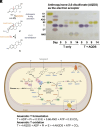Bacterial estrogenesis without oxygen: Wood-Ljungdahl pathway likely contributed to the emergence of estrogens in the biosphere
- PMID: 40053361
- PMCID: PMC11912376
- DOI: 10.1073/pnas.2422930122
Bacterial estrogenesis without oxygen: Wood-Ljungdahl pathway likely contributed to the emergence of estrogens in the biosphere
Abstract
Androgen and estrogen, key sex hormones, were long thought to be exclusively produced by vertebrates. The O2-dependent aromatase that converts androgen to estrogen (estrogenesis) has never been identified in any prokaryotes. Here, we report the finding of anaerobic estrogenesis in a Peptococcaceae bacterium (Phosphitispora sp. strain TUW77) isolated from the gut of the great blue-spotted mudskipper (Boleophthalmus pectinirostris). This strain exhibits testosterone fermentation pathways, transforming testosterone into estrogens and androstanediol under anaerobic conditions. Physiological experiments revealed that strain TUW77 grows exclusively on testosterone, utilizing the androgenic C-19 methyl group as both the carbon source and electron donor. The genomic analysis identified three copies of a polycistronic gene cluster, abeABC (anaerobic bacterial estrogenesis), encoding components of a classic cobalamin-dependent methyltransferase system. These genes, highly expressed under testosterone-fed conditions, show up to 57% protein identity to the characterized EmtAB from denitrifying Denitratisoma spp., known for methylating estrogen into androgen (the reverse reaction). Tiered transcriptomic and proteomic analyses suggest that the removed C-19 methyl group is completely oxidized to CO2 via the oxidative Wood-Ljungdahl pathway (WLP), while the reducing equivalents (NADH) fully reduce remaining testosterone to androstanediol. Consistently, the addition of anthraquinone-2,6-disulfonate, an extracellular electron acceptor, to testosterone-fed TUW77 cultures enabled complete testosterone conversion into estrogen without androstanediol accumulation (anaerobic testosterone oxidation). This finding of aromatase-independent estrogenesis in anaerobic bacteria suggests that the ancient WLP may have contributed to the emergence of estrogens in the early biosphere.
Keywords: C1 metabolism; Wood–Ljungdahl pathway; anaerobic microbiology; aromatics; methyltransferase.
Conflict of interest statement
Competing interests statement:The authors declare no competing interest.
Figures




Comment in
-
Bacteria on steroids.Proc Natl Acad Sci U S A. 2025 Apr;122(13):e2503396122. doi: 10.1073/pnas.2503396122. Epub 2025 Mar 24. Proc Natl Acad Sci U S A. 2025. PMID: 40127283 Free PMC article. No abstract available.
References
-
- Ryan K. J., Biochemistry of aromatase: Significance to female reproductive physiology. Cancer Res. 42, 3342s–3344s (1982). - PubMed
-
- Mechoulam R., Brueggemeier R., Denlinger D., Estrogens in insects. Cell Mol. Life Sci. 40, 942–944 (1984).
-
- Tarrant A. M., Blomquist C. H., Lima P. H., Atkinson M. J., Atkinson S., Metabolism of estrogens and androgens by scleractinian corals. Comp. Biochem. Physiol. B Biochem. Mol. Biol. 136, 473–485 (2003). - PubMed
-
- Miyairi S., Fishman J., Radiometric analysis of oxidative reactions in aromatization by placental microsomes. J. Biol. Chem. 260, 320–325 (1985). - PubMed
MeSH terms
Substances
Grants and funding
LinkOut - more resources
Full Text Sources
Miscellaneous

